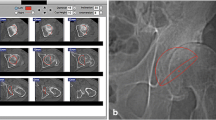Abstract
Background
The incorporation of bulk bone grafts in the replacement of dysplastic acetabulum is determined by the biological environment of the recipient site, the size of the contact surface, and the stability of the osteosynthesis used. Based on these, the present study compares the Harris acetabular plasty used routinely by us with the Radojević L-shaped graft technique.
Methods
For our measurements, we used 20 hemi-pelvises removed from 10 cadavers. In 10 cases, acetabular plasty according to Harris, in 10 cases Radojević L-plasty, was performed. The biological environment was analyzed; with geometric calculations, the contact surface was determined, and with a material testing apparatus, the primary stability of the osetosynthesis was measured. For the measurements, a new method was developed.
Results
The Radojević technique provides a better biological environment for graft ingrowth. The contact surface is nearly twice as much as in Harris plasty. No significant difference was found in the primary stability of the osteosynthesis used. The deviation on the value of the stability measurements is explained by the differences in the bone quality of the cadavers used.
Conclusions
Based on the 3 aspects examined, the Radojević L-shaped graft technique has similar stability when compared to the Harris acetabular plasty, but provides better biological circumstances and larger graft host bone contact. Based on this, we started using the L-shaped technique in our department.









Similar content being viewed by others
References
Harris WH, Crothers O, Oh I (1977) Total hip replacement and femoral head grafting for severe acetabular deficiency in adults. J Bone Joint Surg Am 59(6):752–759
Hasegawa Y, Iwata H, Iwase T, Kawamoto K, Iwasada S (1996) Cementless total hip arthroplasty with autologous bone grafting for hip dysplasia. Clin Orthop Relat Res 324:179–186
Yamaguchi T, Naito M, Asayama I, Shiramizu K (2004) Cementless total hip arthroplasty using an autograft of the femoral head for marked acetabular dysplasia: case series. J Orthop Surg (Hong Kong). 12(1):14–18
Glynn A, Connolly P, McCormack D, O’Byrne J (2005) Use of a cementless modular implant for arthroplasty in developmental dysplasia of the hip: early results. Eur J Orthop Surg Traumatol 15:105–108
Gul R, Masterson E (2005) Cementless total hip arthroplasty in the treatment of severe hip dysplasia or dislocated hips. Eur J Orthop Surg Traumatol 15:101–104
Kivi MM, Mobarakeh MK, Asadi K, Motlagh KH, Ekhtiari KS (2012) Evaluation of clinical outcomes of cementless total hip arthroplasty in patients under 30 years of age. Eur J Orthop Surg Traumatol (published online 2012 September 27)
Chougle A, Hemmady MV, Hodgkinson JP (2005) Severity of hip dysplasia and loosening of the socket in cemented total hip replacement. A long-term follow-up. J Bone Joint Surg Br 87(1):16–20
Gerber SD, Harris WH (1986) Femoral head autografting to augment acetabular deficiency in requiring total hip replacement. A minimum five-year an average seven-year follow-up study. J Bone Joint Surg Am 68(8):1241–1248
Hendrich C, Mehling I, Sauer U, Kirschner S, Martell JM (2006) Cementless acetabular reconstruction and structural bone-grafting in dysplastic hips. J B Joint Surg Am 88(2):387–394
Bobak P, Wroblewski BM, Siney PD, Fleming PA, Hall R (2000) Charnley low-friction arthroplasty with an autograft of the femoral head for developmental dysplasia of the hip. The 10- to 15-year results. J Bone Joint Surg Br 82(4):508–511
Kobayashi S, Saito N, Nawata M, Horiuchi H, Iorio R, Takaoka K (2003) Total hip arthroplasty with bulk femoral head autograft for acetabular reconstruction in developmental dysplasia of the hip. J Bone Joint Surg Am 85(4):615–621
Radojević B, Zaltić M (1990) L-shaped bone graft for acetabular deficiency. J Bone Joint Surg Br 72(1):152–153
Zlatić M, Radojević B, Lazović C (1990) Reconsruction of the hypolpastic acetabulum in cementless arthroplasty of the hip. Int Orthop 14:371–375
Kim M, Kadowaki T (2010) High long-term survival of bulk femoral head autograft for acetabular reconstruction in cementless THA for developmental hip dysplasia. Clin Orthop Relat Res 468(6):1611–1620
Mulroy RD Jr, Harris WH (1990) Failure of acetabular autogenous grafts in total hip arthroplasty. Increasing incidence: a follow-up note. J Bone Joint Surg Am 72(10):1536–1540
Shinar AA, Harris WH (1997) Bulk structural autogenous grafts and allografts for reconstruction of the acetabulum in total hip arthroplasty. Sixteen-year-average follow-up. J B Joint Surg Am 79(2):159–168
Kwong LM, Jasty M, Harris WH (1993) High failure rate of bulk femoral head allografts in total hip acetabular reconstructions at 10 years. J Arthroplast 8(4):341–346
Simsek A, Cila E, Sener E, Senkoylu A, Sipahioglu S, Akdemir O, Atasever T (2006) Fate of bulk autografts in uncemented total hip arthroplasty. Evaluation by bone scintigraphy. Saudi Med J 27(12):1835–1838
Stevenson S, Sanford E, Goldberg V (1996) Factors affecting bone graft incorporation. Clin Orthop Relat Res 324:66–74
Lamerigts NMP, Buma P, Huiskes R, Schreurs W, Gardeniers J, Slooff TJJH (1999) Incorporation of morsellized bone graft under controlled loading conditions. A new animal model in the goat. Biomaterials 21:741–747
Kanda A, Kaneko K, Obayashi O, Mogami A, Iwase H (2012) Limitation of total hip arthroplasty of the acetabular roof by press-fit without screw fixation: discussion of a biomechanical study. Eur J Orthop Surg Traumatol (published online 2012 April 07)
Anderson MJ, Harris WH (1999) Total hip arthroplasty with insertion of the acetabular component without cement in hips with total congenital dislocation or marked congenital dysplasia. J Bone Joint Surg Am 81:347–354
Conflict of interest
None.
Author information
Authors and Affiliations
Corresponding author
Rights and permissions
About this article
Cite this article
Szabó, J., Manó, S., Lőrinc, Á. et al. The biological and biomechanical comparison of two bulk bone graft techniques used in case of dysplastic acetabulum. Eur J Orthop Surg Traumatol 24, 679–684 (2014). https://doi.org/10.1007/s00590-013-1246-6
Received:
Accepted:
Published:
Issue Date:
DOI: https://doi.org/10.1007/s00590-013-1246-6




